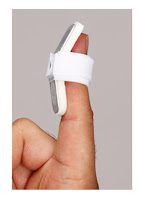 |
| Our Price : Rs 61 |
Mallet finger Specially design to correct the Tynor Mallet Finger Splint deformity. Designed to support the dip joint in hyper- extension, while permitting unrestricted movement of the PIP joint.
- Sleek and convenient.
- Customizable dorsiflexion.
- Comfortable cushioning.
- One universal size.
Tynor Mallet Finger Splint Features :
- Coated aluminum body
- Malleable can be bent and customized
- Strong, provides rigid immobilization
- Light weight
- Ergonomic design
- Highly practical design to maintain the requisite hyper extension of DIP joint
- Well ventilated and comfortable
- Sleek and simple –Better compliance
- Easy application and removal.
- Ethafoam lining
- High cushioning
- Enhanced comfort
- Easy to clean and maintain.
- Inbuilt Hook loop fasteners
- Close fitting and excellent grip
- Easy application and removal.
Wrist Wrap (Neoprene) is designed to Wrist Support, protect and partially immobilize the wrist. It compresses the area and retains the body heat to allay local pain and inflammation.
Extra grip.
- Versatile closing system.
- Optimal therapeutic warmth.
- Easy application.
- Four way compression.
Tynor Wrist Wrap (Neoprene) Features :
- Neoprene layer bonded with nylon fabric on both sides
- Four way strechability and compression.
- Ensures longer life.
- Appealing aesthetics with color fastness.
- Wrap around design and UBL closing system
- Ensure easy application and removal
- Customized compression and fitting
- Better fitting
- Better support and wrist stabilization
- Thicker neoprene
- Better body heat retention.
- Increase blood circulation.
- Faster healing.
The Wheelchair is an India based online handicapped product shopping website offers a large variety of handicap products and at amazingly low prices. Avail benefit of latest promotions on Wheelchairs, Tricyle, handicap walker, handicap crutches, handicap sticks, folding commode , handicap cycle rickshaw, handicap moped and other health product.



















